Bell 47G - History and technical description
Some historical notes
The Bell 47G, built in the 1950s by the Bell Aircraft Corporation, is an improved version of the D1, the first helicopter of the series 47 capable to transport along with the pilot two passengers instead of one. The Bell 47D1, which appeared in 1949, was successfully used by civil and military operators. During the Korean War this helicopter, known as the H-13D and H-13E (USAF) or HTL-4 and HTL-5 (US Navy), was intensively used as an aerial ambulance to transport the wounded to the Mobile Army Surgical Hospitals (MASH) units.
The Bell 47G obtained the CAA certification on June 19, 1953. The first deliveries to civil customers started shortly after. That year Bell sold its 1'000th Bell 47.
In 1953 the sale price of a Bell 47G equipped with skid-type landing gear and base equipment was of about 38'000 US dollars (the equivalent of approximately 185'000 Sfr.).
This model became the star of the American television series “Whirlybirds” produced by Desilu studios in the late 1950s.
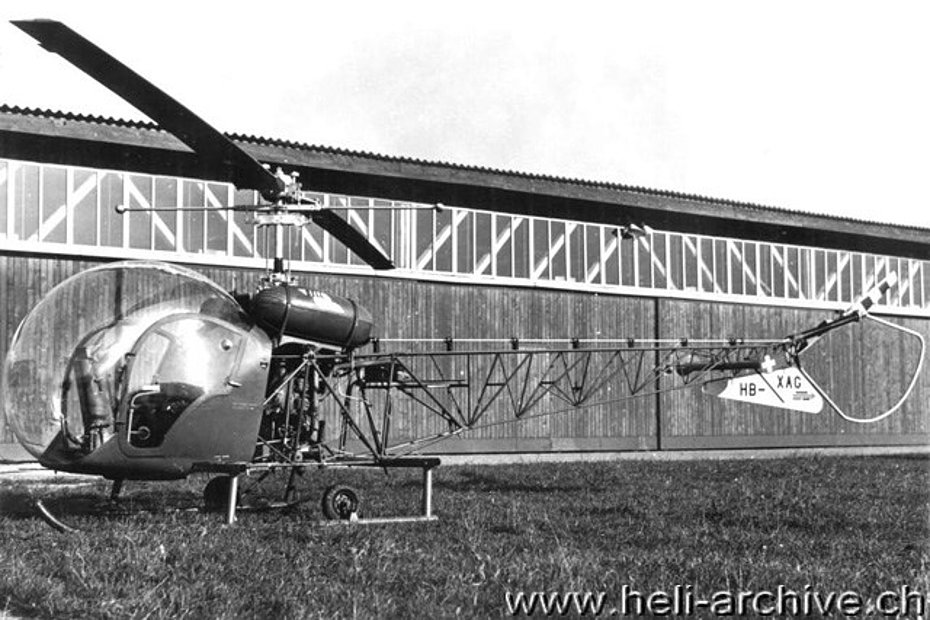
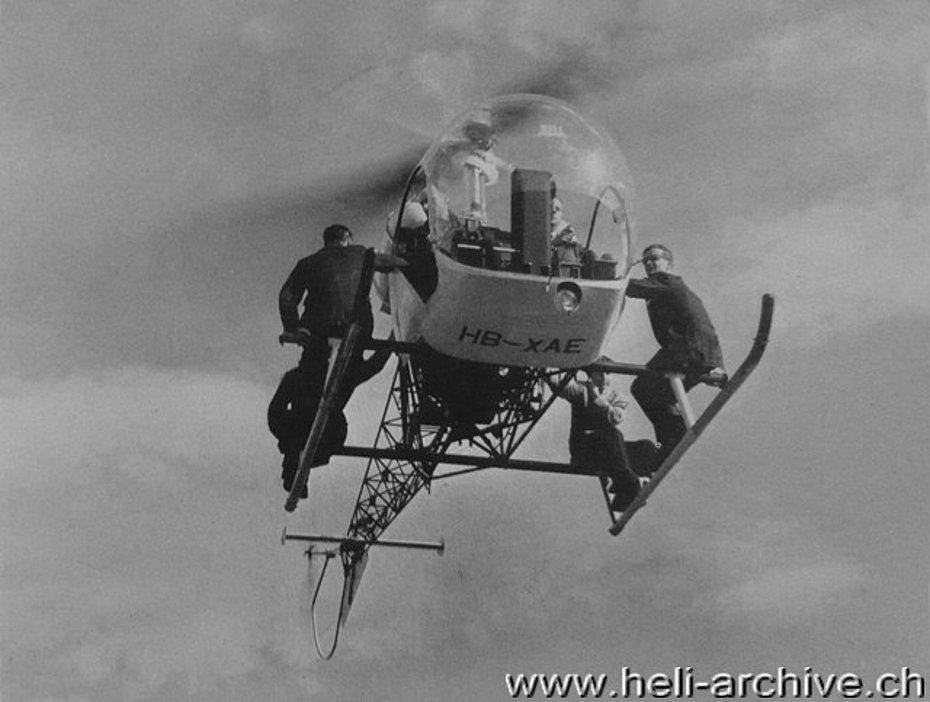
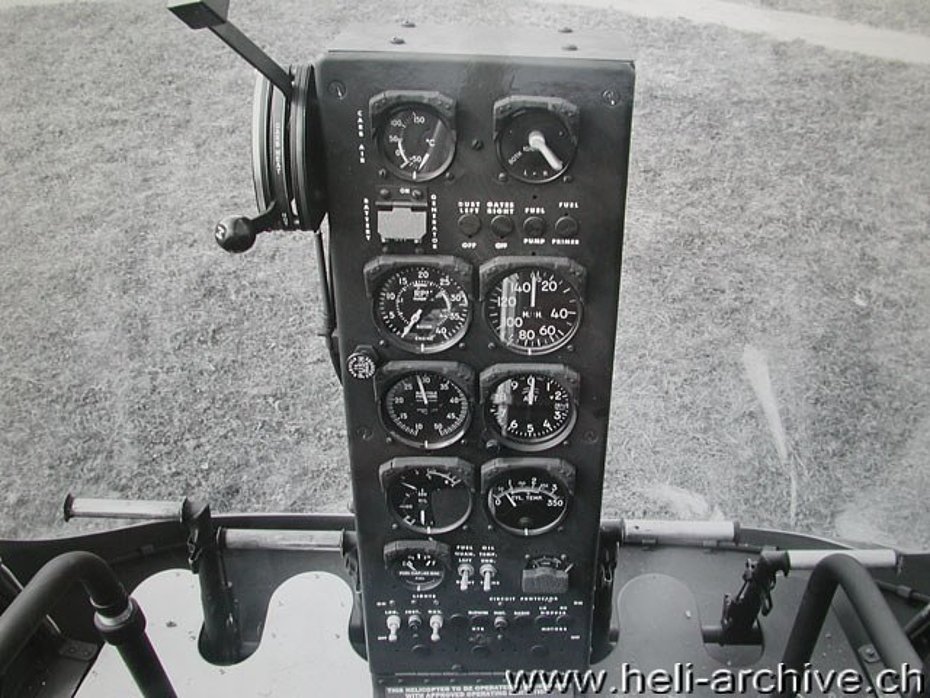
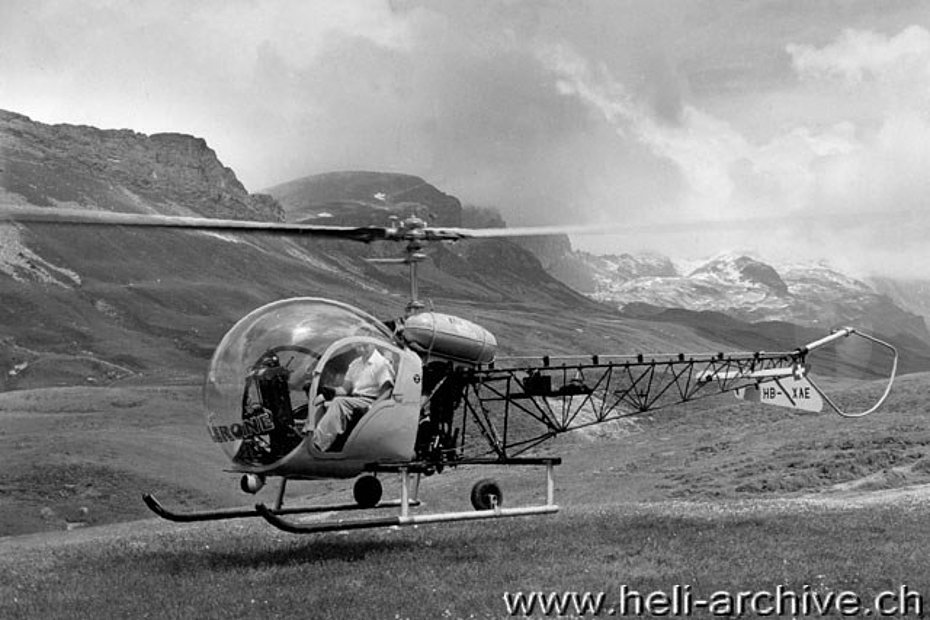
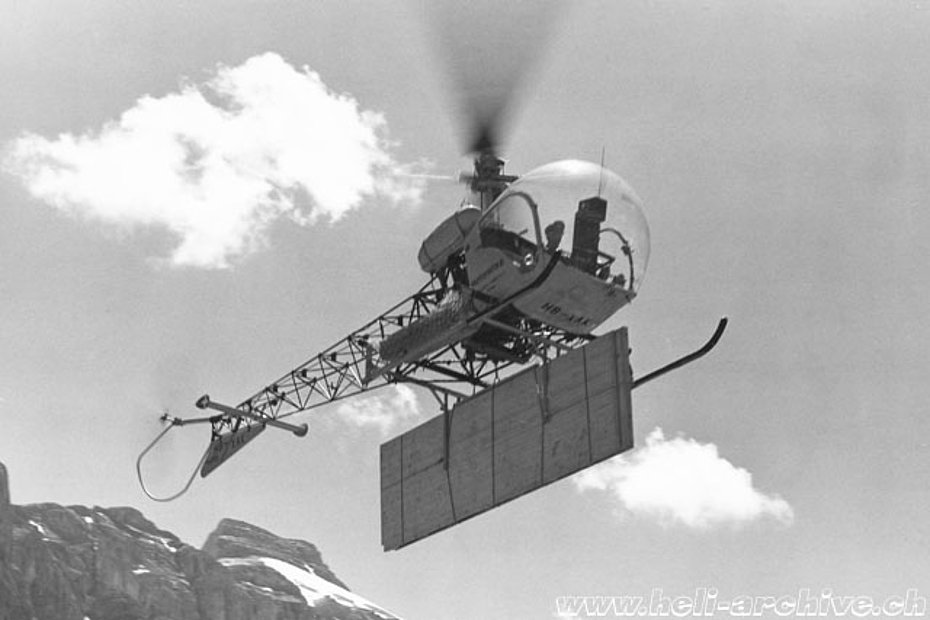
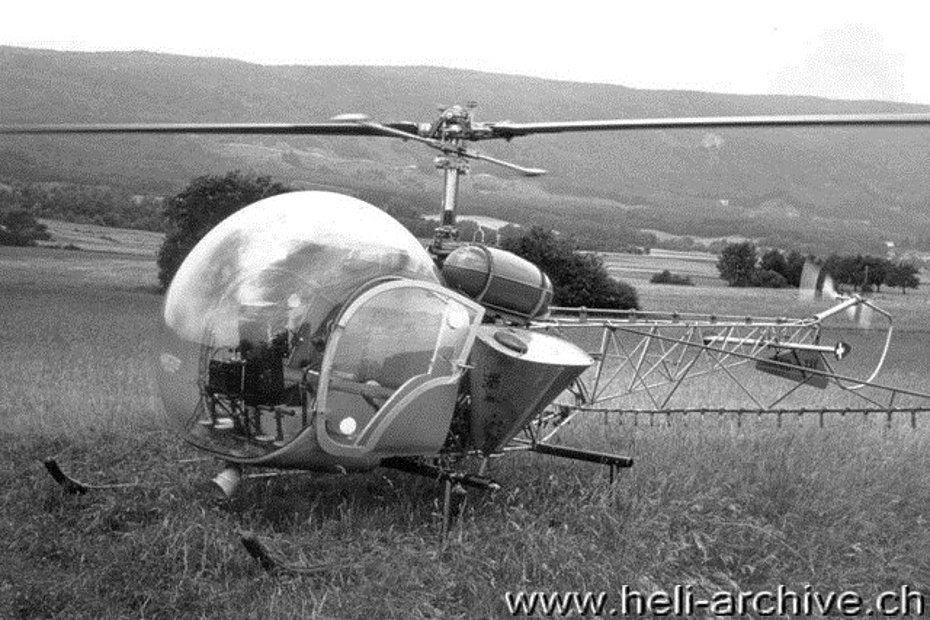
Civil employ
The Bell 47G was primarily used for the transportation of passengers and goods, agricultural operations, transport of mail, observation, reconnaissance, photographic flights and school.
Technical description
The Bell 47G is a three place helicopter (the pilot seats on the left with the two passengers seated side-by-side on the same bench) of standard configuration. It has a two-blade main rotor (the main blades are made of laminated wood) with a stabilizer bar and a two blade tail rotor. Its cabin is protected by a "bubble" made of Plexiglas (one of the main characteristic of this model which gives unequalled visibility in all directions), and is accessible from each side through quickly removable doors. The helicopter was usually delivered with a skid landing gear, but for amphibious operations it could be also equipped with a float landing gear.
The original Bell 47G was powered by a six cylinders horizontally-opposed fan-cooled Franklin 6V4-200-C32 Franklin engine with a maximum power of 149/200 kW/hp at 3'100 rpm. The helicopter has a two-stage planetary transmission with a 9:1 reduction ratio.
On this version there are two interconnected gravity fuel tanks located on the centre of gravity with a total capacity of 162 litres (instead of 91 litres as on the D1). Compared to the precedent versions the range is consequently extended by 35 percent. A selector permits to separately read the quantity of fuel in each tank.
The Bell 47G is equipped with a synchronized tail elevator controlled by the cyclic stick. The elevator makes cabin load variation less critical (40 percent more allowable C.G. travel, up to 250 kg of load in the cabin), increases maneuverability and eliminates battery shifting.
The electrical system incorporates a 50 Ah 28 volt generator, and a heavy-duty battery for quick, dependable engine start. There is obviously also an external power receptacle.
Another novelty on this version is the introduction of metal tail rotor blades, and a new vertical fin made of aluminium, more robust and lighter than the precedent.
There are also other improvements as the new positioning of the Pitot tube for a more precise lecture of the indicated airspeed, new (and lighter) cabin cushions, an improved mast greasing, new silent-block of the engine, a new fastening of the engine's fan, new arrangement of the air filter, a new protection against dust of certain mechanical rotating parts, a new placement of the tail rotor control cables, a new tail rotor control system which reduces at the same time the operating cost, an improved wiring, new positioning of the landing light which enlightens the tail rotor for safer night flight operations, and finally new skids with steel reinforcements.
Performance data
With a gross weight of 1'065 kg the Bell 47G has a max. cruising speed (at sea level) of 144 km/h and a standard cruising speed of 123 km/h. The never exceed airspeed from sea level up to an altitude of 430 meters is 161 km/h. From this altitude up the cruising speed must be decreased of 1.84 km/h for each additional 100 meters of climb. The maximum rate of climb at 72 km/h is 244 m/min. The time to climb to 1’525 meters is about 8 minutes. At its maximum gross weight the helicopter has a service ceiling of 3'810 meters, while the hovering ceiling in ground effect (IGE) is theoretically possible at an altitude of approximately 1'100 meters. The maximum range is 345 km.
These performance data are based on operation in still air (zero wind) under NACA standard atmospheric conditions.
Rotor and engine limitations
During normal operations in flight the main rotor rpm must be kept between 294 and 360 rpm, while the engine rpm must be kept between 2'900 and 3'100 rpm (oil pressure 40-60 psi and cylinders head temperature 100 to 224°C).
Dimensions, weights and payload
The main rotor of the Bell 47G has a diameter of 10.72 m, while the tail rotor has a diameter of 1.72 m. The fuselage, made of welded steel tubes, triangular in cross-section, has a total length of 8.33 m. The max height of the helicopter is 2.79 m.
The empty weight of the helicopter fitted with a skid-type landing gear is of approximately 645 kg, while its max take-off weight (MTOW) is 1’065 kg. Deduced the std weight of the pilot (77 kg), and with a fuel and oil reserve for one hour of flight the payload is approximately 300 kg.
Autorotation
In case of engine or tail rotor failure the pilot must immediately execute an autorotation maintaining an indicated airspeed of at least 64 km/h. At an altitude of 15 metres over the landing place he must decelerate constantly. At 3 metres over the ground the pilot must apply collective pitch as necessary in order to cushion the landing.
Accessories
To multiply the versatility a number of accessory kits were available for installation on the Bell 47G. Among them there were dual controls, night flight equipment (which included position light, landing light, instrument panel illumination and cabin interior light), floats for operation from land, water, marsh, ice or snow, external litters attached to the cross tubes of the landing gear, spraying, dusting or fogging equipment, kit for the transportation of sling loads, snow shoes, hydraulic boost servos for the cyclic control, external cargo carriers, radio, cockpit heater and defroster, rotor brake, fire extinguisher, first aid kit and a shoulder harness kit.
The Bell 47G in Switzerland
The first Bell 47G to be registered in Switzerland was the HB-XAG (s/n 668 b/y 1953 ex. F-BGXS) purchased in September 1953 by the Schweizerische Helikopter AG (later Heliswiss). This aircraft arrived in flight from Paris on October 8, 1953, but unfortunately it was destroyed in a tragic accident on the following October 26.
It was replaced by the HB-XAE (s/n 689 b/y 1954) purchased directly from the Forrer-Fenwick of Zürich (Bell's representative in Switzerland). The cost of this helicopter fitted with dual controls and a night flight equipment was 38'762 US dollars. With the delivery and the custom duties the total price paid by the Swiss helicopter company was of 210'000 Sfr.
The new helicopter was crated and transported with a cargo airplane to Zürich on the 27th of February 1954. It was then assembled and on March 25 the French pilot Jean Moine arrived in Switzerland for the first flights, because none of the Swiss pilots was in possession of the necessary qualifications to fly with this model.
Few days later the Swiss pilot Leonard Kunz went to France with Moine to complete the transition course. During the test flight in Belp Moine took-off with five passengers to demonstrate the power of the G model. Four of them were seated on the landing gear cross tubes (see picture).
The HB-XAK (s/n 1305 b/y 1954) was also transported by airplane and arrived in Switzerland on December 6, 1954, but it was put into service only on February 25, 1955. Both helicopters were used for passenger flights, demonstrations, flying school, photographic and reconnaissance flights, aerial spray and early transportation of building material in the Swiss Alps.
The last G to enter in service was the Agusta-Bell 47G HB-XAV (s/n 101 b/y 1957). The Italian firm Costruzioni aeronautiche Giovanni Agusta Spa in Cascina Costa had in the meantime started the production in series (under license from Bell) of this model. Heliswiss became an important civil customers of the Italian company and ordered several models. Among them the latter mentioned.
The limited performances of the Bell 47G became more and more evident during its employ in the Swiss Alps in the period between 1955-56. To improve the limited performance of the helicopter, sometimes, especially during the summer monts, it was lightened as much as possible. Pilots in fact frequently asked mechanics to remove from the helicopter various non-essential parts to the flight such as the left fuel tank, the battery, the alternator, the radio equipment, the doors and even the seat cushions. In this way it was possible to reduce the empty weight of the helicopter of about 30-40 kg and increase the payload. Let's not forget that the Bell 47G was initially used as an aerial crane at altitudes exceeding 2'500 meters.
On August 19, 1955 for example Leonard Kunz rescued an injured hiker in the region of the Tödi at an altitude of 2'650 meters. Between November 7-9 1955 Kunz transported for the Societé Anonyme d’Energie de l’Ouest Suisse a group of geologist in the Val d’Hérens and landed on the Col de La Maina at an altitude of 2'700 meters. These performances are really remarkable if we think that the helicopter was powered by a 149/200 kW/hp engine!
With the apparition of the more powerful (Agusta-)Bell 47G2, which had a 194/260 kW/hp Lycoming VO-435 engine, Heliswiss decided sold HB-XAE for 120'000 Sfr. to the French company Fenwick which registered it F-BHMH.
The helicopters with call signs HB-XAK and the HB-XAV remained in service with Heliswiss for some years, even if they were not more used for transportation in the Alps anymore. Both went then lost in accidents.
For unknown reasons frequently the Swiss pilots erroneously indicated the (Agusta-)Bell 47G as the G-1 (this designation was officially used by Bell to indicate at the beginning the prototype of the J).
HAB 05/2010

